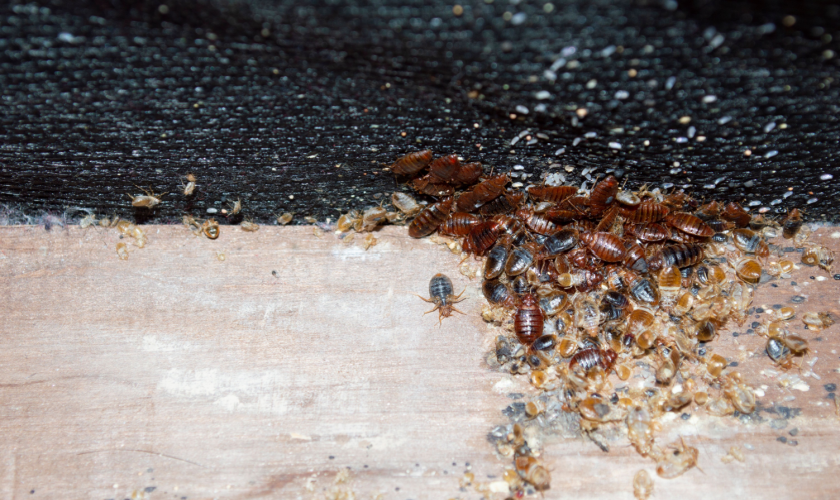Understanding the Lifecycle of Bugs for Targeted Control Approaches
Understanding the lifecycle of parasites is a basic element of efficient pest administration techniques. By comprehending the numerous stages of development that insects undertake, a much more targeted and accurate technique can be adopted to control their populaces. This expertise not only drops light on the susceptabilities within the bug lifecycle yet additionally paves the way for executing calculated procedures that can disrupt their development and recreation cycles. Via a deeper understanding of exactly how insects progress and flourish, customized control techniques can be designed to attend to specific points in their lifecycle, inevitably leading to even more effective insect monitoring results.
Relevance of Recognizing Bug Lifecycle
Recognizing the lifecycle of pests is vital for developing efficient and targeted control strategies in pest management. By comprehending the different phases a pest goes with from egg to grownup, insect control experts can recognize weak spots in the lifecycle where intervention can be most effective. Knowing when larvae are most active can help establish the optimum timing for using larvicides. Additionally, understanding the lifespan of a parasite varieties can aid in predicting populace growth patterns and prospective infestation threats.
Moreover, recognizing the specific environmental problems required for every phase of the bug's lifecycle can lead decisions on environment modification or exemption techniques to decrease and interrupt the lifecycle bug populaces. This understanding enables pest administration experts to apply proactive actions rather than counting entirely on reactive treatments, leading to even more sustainable and long-lasting insect control services. Ultimately, a detailed understanding of bug lifecycles equips pest control specialists to customize their approaches effectively, making the most of and reducing environmental influences control outcomes.
Key Phases in Pest Growth
To effectively apply targeted control methods in parasite administration, a crucial facet hinges on adequately determining and understanding the vital phases in pest advancement. Parasite advancement generally is composed of a number of key phases that are crucial for their lifecycle and management. The initial stage is the egg phase, where pests lay eggs that later hatch out into larvae. Larvae then advance into pupae, a stage where they go through metamorphosis before becoming grown-up pests. Understanding these phases is essential as it assists in identifying weak spots in the lifecycle where control measures can be most reliable.

Susceptabilities in Pest Lifecycle
Throughout the different phases of an insect's lifecycle, distinct vulnerabilities emerge that can be tactically targeted for efficient control measures. One important vulnerability hinges on the egg phase, where bugs are frequently more vulnerable to certain insecticides or organic control representatives as a result of their soft external shell, making them less complicated targets for treatment. In addition, the larval or nymph phase offers susceptabilities as insects undergo fast development and growth, requiring high energy usage that can be made use of by disrupting their food resources or presenting development preventions. Pupal phases, identified by stability and change, provide a window for targeted control with physical barriers or details treatments that prevent effective emergence. Ultimately, adult bugs, while extra durable due to their reproductive capacity, can still be at risk during breeding or egg-laying tasks, which can be interfered with through pheromone traps or sterilization strategies. Recognizing these vulnerabilities in the parasite lifecycle is important for establishing specific and reliable control strategies that efficiently handle bug populaces while lessening environmental effect.
Executing Targeted Control Procedures

Implementing targeted control measures commonly entails a multi-faceted technique. This may include habitat modification to make the atmosphere less friendly to bugs, such as getting rid of standing water for insect control or sealing entry factors for rats. Furthermore, organic control methods can be used, where natural predators or microorganisms are introduced to maintain parasite populations in check.
Chemical control, such as the cautious application of chemicals, is another typical strategy. Nonetheless, it is important to use these materials judiciously to Get More Info decrease ecological effect and prospective harm to non-target varieties. Integrated Pest Administration (IPM) techniques that integrate different control actions in a coordinated and lasting fashion are often the most efficient in accomplishing long-term parasite monitoring objectives. By carrying out targeted control measures based on a complete understanding of parasite lifecycles, parasite populations can be properly managed while decreasing risks to human health and wellness and the atmosphere.
Enhanced Parasite Administration Practices

Moreover, the unification of biological control agents, such as natural predators or microorganisms of pests, can help in reducing reliance on chemical pesticides and advertise a more balanced ecosystem. Carrying out physical obstacles and traps can additionally belong to improved bug management techniques, using non-toxic and targeted services for pest control. Additionally, making use of pheromones and other semiochemicals can interrupt pest breeding patterns and interaction, leading to reduced bug populaces with time.
Final Thought
Finally, understanding the lifecycle of parasites is important for reliable pest administration methods. By determining essential stages in pest development and susceptabilities in their lifecycle, targeted control actions can be implemented to minimize insect populaces. Enhanced pest administration methods can help in reducing the reliance on broad-spectrum chemicals and advertise more environmentally friendly and sustainable pest control approaches. This understanding plays a crucial function in keeping healthy communities and farming efficiency.
Understanding the lifecycle of pests is vital for developing reliable and targeted control techniques see this here in pest monitoring. By comprehending the different stages a parasite goes through from egg to grownup, parasite control specialists can identify susceptible points in the lifecycle where treatment can be most successful. Inevitably, a comprehensive understanding of pest lifecycles empowers insect control experts to customize their strategies effectively, maximizing and minimizing ecological impacts control results.
By carrying out targeted control procedures based on a comprehensive understanding of pest lifecycles, pest populaces can be efficiently regulated while decreasing risks to human wellness and the environment.
By determining essential phases in bug advancement and susceptabilities in their lifecycle, targeted control measures can be implemented to minimize parasite populaces.